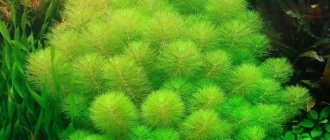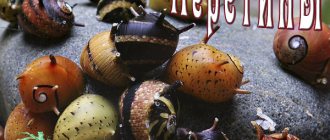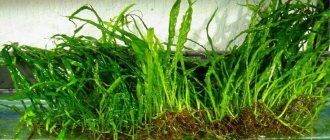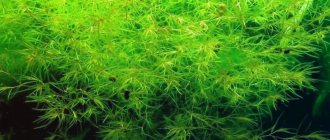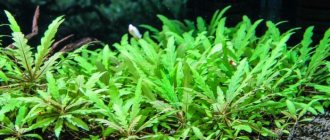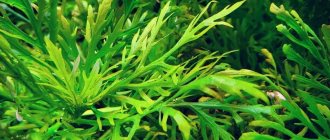Among aquarium plants, Echinodorus can be called perhaps the most common species. This large and bright plant is quite unpretentious and has many varieties. One of the most common among aquarists is Echinodorus Amazonis, or simply the Amazon.
Among aquarium plants, Echinodorus can be called perhaps the most common species.
Origin and description
The name of the plant speaks for itself and it is not difficult to guess where it came from. On the banks of the Amazon River, in the reservoirs of Cuba, the USA and Brazil, you can still find many echinodorus of this species. The hydrobiont has a spectacular appearance. It reaches 40 cm in height, the rosette of its leaves can spread up to 30 cm or more. The leaf is lanceolate in shape and rich green in color, its width is 3-4 cm. Young leaves are painted in a light green tint. There are 3 noticeable light veins along the leaf. The leaves are located on short petioles.
In an aquarium, the Amazon is planted in the middle or background of the aquarium; it perfectly serves as the main accent in the aquarium design.
Content
- 1 Design
- 2 Terms
- 3 Features
- 4 Ground
- 5 Recommendations
- 6 Reproduction
Source: www.plantedtank.net
Source: www.plantedtank.net
Source: www.plantedtank.net
- Other names: Echinodorus amazonicus.
- Origin: South America, Amazonia.
- Size: 35-40 cm.
- Temperature: 16-28 °C.
- Water parameters: pH, dKH °.
- Lighting: 0.25—0.7 W/l.
- Growth rate: high.
- Content difficulty: low.
Lighting requirements
Echinodorus amazonica, the contents of which are quite accessible even to beginners, does not require particularly bright lighting. He will be quite happy with diffused light of medium intensity (0.5 W/l). The hydrobiont is able to tolerate prolonged shading, but its appearance is significantly deteriorated and growth practically stops. To preserve the decorative appearance of the leaf rosette , it is important that the aquarium is illuminated for at least 8-10 hours a day . T8 fluorescent lamps or LED housekeepers are suitable.
Compatibility
When starting to plant Echinodorus in an artificial reservoir, you should take into account its compatibility with other types of flora. Thus, when selecting according to the requirements of lighting, temperature and other important indicators of the habitat, you should definitely take into account the size of the final form in order to avoid further shading and/or displacement of the crop.
It is not particularly recommended to plant it next to Cryptocoryne, but Sagittaria will make a pretty good neighbor.
Echinodorus is an excellent choice for landscaping aquariums, including cichlids, as well as paludariums, terrariums and even greenhouses, becoming not only an indispensable decorative element, but also a complete shelter and source of oxygen for both fish and amphibians and reptiles.
Soil features
All Echinodorus prefer nutritious, well-silted soil. These plants have a very powerful root system , which requires a large volume for optimal development. Therefore, the thickness of the soil where echinodorus amazonicus is grown must be at least 7 cm. The soil can consist of either sand or small or medium-sized pebbles. It is much more important that there are enough nutrients in the soil.
If the soil is not naturally silted, clay balls or other fertilizers are added to it, peat or turf can be added for better survival.
All echinodorus prefer nutritious, well-silted soil
Reproduction
Echinodorus Amazonis reproduces only vegetatively. A peduncle is formed in the rosette, on which daughter plants are formed. The flower stalks look like arrows with small nodules at the ends. When newly formed shoots begin to produce roots, they should be fixed in the ground.
It is enough to press it a little to the substrate with the help of stones or lightly bury it. On average, new rosettes can be planted in an aquarium after they reach a length of 10 cm.
Water parameters
For cultivation, water with a temperature of 22 to 25 degrees is most suitable, but some increase and decrease in temperature is acceptable. The hardness should not exceed 15°dH; if it increases, the plant will not die, but a white limescale may form on the leaves. The acidity of the water does not greatly affect the condition of the plant, but it is desirable that it be close to neutral. The most important parameter for echinodorus is a sufficient amount of nutrients in the water and soil. The supply of CO2 is not necessary, but its supply will have a positive effect on the appearance and growth rate.
Botanical properties
Echinodorus (from Latin Echinodorus) is a perennial marsh herbaceous plant with leaves of various shapes, sizes and colors. A typical species characteristic is the presence or absence of a transparent (and sometimes darker than the base) color pattern consisting of lines or dots. Being a rather unpretentious plant in terms of water hardness, pH level and temperature, it is tolerant of changes, which is why it is easy to grow, and some varieties even feel comfortable on land.
The sizes of Echinodorus vary from a few centimeters to one and a half meters in height, depending on the species and conditions of detention. During the flowering period, it forms a long peduncle with a small inflorescence at the top.
General rules of care
Echinodorus ocelot is a rosette-shaped bush with a diameter of up to 50 cm. Large oval leaf plates are attached to powerful roots by cuttings. The plant can grow up to 40-50 cm in height. Therefore, the height of the aquarium should be at least 50 cm.
The size of the aquarium is of great importance due to the large dimensions of the plant itself.
The root system of the ocelot is branched. Therefore, you need to plant the bush as deep as possible. The dimensions of the aquarium must correspond to the dimensions of the plant. It is recommended to choose a container with a volume of 100-150 liters.
If you choose a smaller tank, the overgrown Echinodorus will take up the entire space. A container that is too tight will lead to the death of the crop.
The amount of water also matters. Low fluid levels provoke the formation of unsightly airy leaves.
Airy leaves of Echinodorus spoil the appearance of the plant and the aquarium as a whole.
The process of planting an ocelot in an aquarium is as follows:
- the plant is removed from the soil;
- remove small shoots from the rhizome;
- place the culture in the substrate;
- transferred to a tank for a permanent location.
Caring for an ocelot is simple, even inexperienced aquarists can do it. But, despite the fact that the plant is able to survive under unsuitable parameters, it is necessary to provide it with conditions for successful growth.
The crop is planted in a layer of soil mixture 8-10 cm thick. The substrate is prepared from a mixture of river sand, small pebbles and granite chips. It is also possible to use any one of these elements as a primer.
Echinodorus loves warmth and is able to survive in liquid heated to 30 ° C, however, this is the limit value and a lower temperature is recommended for permanent residence of the plant. The most acceptable water parameters are those presented in the table:
| Temperature (°C) | Acidity (pH) | Hardness (dGH) |
| 20-26 | 6 — 7,5 | 5-15 |
If the soil chosen for Echinodorus is well silted, then the use of additional fertilizing will not be necessary. The ocelot will have enough valuable elements formed naturally in an artificial reservoir. If the soil is not silted, nutrient balls made from a mixture of clay and charcoal or peat are placed under the rhizome.
Peat fertilizer for an aquarium should be used strictly according to the instructions.
It is recommended to plant Echinodorus in the center, away from other crops. Otherwise he will obscure them. When planting several specimens of the same species, the bushes are placed at some distance from each other.
Other species of the genus Echinodorus
- Echinodorus spadeleaf
- Echinodorus Asherson
- Echinodorus Blehera or Yarrow
- Echinodorus goremana
- Echinodorus major or Bartha
- Echinodorus vertical
- Echinodorus horizontalis
- Echinodorus speckled
- Echinodorus latifolius
- Echinodorus parviflora
- Echinodorus tender or Echinodorus herbaceous
- Echinodorus osiris
- Echinodorus acuminata
- Echinodorus sellovianus
- Echinodorus cordifolia
- Echinodorus angustifolia
Diseases
Like any living plants, all types of Echinodorus require the care and attention of the aquarist. When kept in an aquarium, the requirements of a certain variety must be carefully observed, otherwise the roots of the flower will begin to rot, and the leaves will turn yellow or dissolve, beginning to die. The most common diseases of Echinodorus include:
- Fine and contaminated soil, as a result of which the roots of the flower rot. Good roots should be white.
- Turbid water with impurities, which causes plant growth to stop.
- Insufficient light - in this case, the leaves turn yellow and die.
Echinodorus feels great in an aquarium with any types of plants and fish; the catfishes Ancistrus and ampularia snails, which clean the leaves, will be especially useful for the flower. However, in such a neighborhood, it should be taken into account that if the leaves of the plant dissolve, then the fish do not have enough food, or there is an overpopulation problem, due to which the pets gnaw the leaves.
Echinodorus in the aquarium are popular plants that have many fans due to their attractive appearance, variety of species and easy maintenance. With a minimum of effort, you can grow a lush green flower in your home pond, which will become a decoration for the tank.
Nutrition
For Echinodorus, you do not need to use any mineral supplements or vitamins. The plant takes all the nutrients necessary for growth and reproduction from the soil. A large number of additional feeds can only harm the plant.
The need to use additional sources of minerals appears only when Echinodorus tender will be in an environment for a long time that is not entirely suitable for its existence. For example, if there are temporary difficulties in ensuring sufficient lighting or cleanliness of aquarium waters.
Breeding
Reproduction of Echinodorus is carried out vegetatively. One of the peculiarities of the culture is the absence of stems. The foliage grows directly from the rhizome. Rhizomes are formed on the root system - seals that release buds, from which stepchildren later grow.
But for the ocelot, this process is slightly different. Its reproduction occurs by arrows, which are released by the mother bush.
After a new rosette grows and 5-6 leaves appear on it, the daughter plant is separated from the parent plant and planted in the ground. It will take a little time to adapt to the new outlet. Having taken root, the young bush begins to actively develop.
Reproduction of Echinodorus occurs by dividing daughter shoots. It is difficult to collect the seeds of a flowering plant at home, but it is even more difficult to grow a seedling from them.
Propagation of Echinodorus by seeds is almost impossible. Despite the fact that the plant can produce flower shoots, full-fledged seeds are rarely formed. You can try to artificially pollinate the bushes with a soft brush. To do this, you need to wait until the fruits are fully ripened. The collected seeds are further dried for 1-2 months. Then they are sown in containers with wet sand.
Luxurious Echinodorus ocelot bushes will decorate any home pond. The plant is easy to care for and goes well with a variety of underwater pets.
